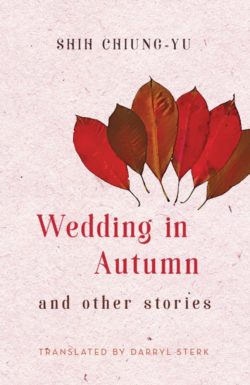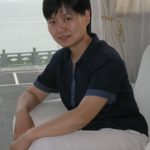Wedding in Autumn, by Shih Chiung-yu
translated by Darryl Sterk
Balestier Press, 2018
Publisher's Blurb
Haunted by memories of the Chinese Civil War in the late 1940s, nationalist soldiers from all over mainland China are doomed to live out their days in exile in Taitung County, along the southeastern shore of the island of Taiwan.
The three novellas in this collection tell stories of Chinese men who were forced to leave their loved ones behind and the aboriginal Amis locals they marry or adopt to try to make themselves at home, often in vain, for their wives and adopted daughters and sons end up knocked up, sexually abused, sold into prostitution, happily married, or insane.
Set in Taiwan in the 1970s and 1980s, Wedding in Autumn and Other Stories captures the suffering and the will to survive of marginalised people everywhere.
Reading Chinese Network Reviews
Reviewed by Esme Curtis, 21/5/21
 The world of Wedding in Autumn is the world of the author's childhood. Shih Chiung-yu's three short stories are set in aboriginal villages in Taiwan in the 1980s. Each novella is a coming of age tale of a young woman, or several young women. Each novella is filled with a cascade of violence and darkness.
The world of Wedding in Autumn is the world of the author's childhood. Shih Chiung-yu's three short stories are set in aboriginal villages in Taiwan in the 1980s. Each novella is a coming of age tale of a young woman, or several young women. Each novella is filled with a cascade of violence and darkness.
The subject matter undoubtedly makes for difficult reading. The first two stories are focussed on women who are repeatedly raped, stuck in cycles of abuse which they passively, mutely receive. Women's bodies, more than their personhood, are the focus of the narrators.
In "Wedding in Autumn", the first short story, the narrator describes how Ah Ju is repeatedly raped by a soldier. One disturbing scene depicts her lying in the "gore" of a miscarriage; "that waste had crawled all over Ah Ju's unclean body". Ah Ju is depicted as being absent of any thoughts or even feelings. Before being raped is described as a "bitch in heat", and framed as less than an animal. Her body is described as dirty and contaminated. But, more disturbingly, she is contrasted with the narrator's intellectual sister, Min-teh.
Unlike the intellectual Min-teh, Ah Ju has "lost every brain cell she ever had". It is this which, the characters observe, explains her repeated rape at the hands of the violent solider who visits the town. Min-teh, on the other hand, is tormented by her own body. Her periods cause her to fall into violent rages, attacking the narrator, and curling up in pain in her bed. "Wedding in Autumn" and "Flee, Ma-wu-k'u River" both divide women into these two categories: those who are talkative, cruel, smart (and thus not raped, it is implied) and those who are silent, passive, dumb (and thus victims of sexual violence). The unrelentingly misogynistic attitudes of the characters in the book and the repeated verbal and physical assaults against women make for grim, joyless reading. Women are praised by villagers only for their obedience, and paid attention to for their bodies.
I do not know how much of the language used in the three short stories is reflective of the translator's choices, and how much is reflective of the original text. I have not read any of these novellas in the original Chinese. However, women's anatomy is often described in the coarsest language and abusive terms are used jarringly and casually. Women are repeatedly, bizarrely sexualised, even within their own inner monologues. In "Flee, Ma-wu-k'u River" a woman is described as thinking to herself how fortunate she is to have had a "wide, plump bottom" to fall on. The vulgar language used often feels both gratingly aggressive and stilted. An old man exclaims "Oh titties!" to himself, for example.
The final story is titled "The Last Whistling Pine, Forgotten by the Windbreak". It is the longest of the three, and also the hardest to follow. It stands out from the others for its relative lack of sexual violence, but its female protagonist remains unerringly passive and focussed on the men in her life who abuse her. It is also the only one which portrays the inner world of the woman it focusses on. And yet, as if to combat this the first person narrator of 'The Whistling Pines' remembers her childhood as if observing it from the distance. She somewhat incoherently struggles within the text to admit that she is the young woman she is describing.
Lines such as "the weight of secrets suddenly a load on her mind, she poured them out to the whistling pines as she swang" are rare reprieves. For a moment, the narrator briefly shifts their focus from women's damaged bodies, instead beautifully capturing the mind of the story's female characters. But such breaks from women's torment are few, fleeting and far between.
The narrative style of the final novella is loose and rambling, difficult to follow. The characters never quite feel real, and instead seem to shimmer on the page. Reading all three of these novellas is like watching a world through a keyhole; it feels as if Shih Chiung-yu knew more of these people's personalities than she shows the reader. I wish the perspectives could have been shifted, the women allowed to come to life. Instead their thoughts and outlook are constantly suppressed, somewhere between stereotype and shadow.
The life of the Amis people in Taiwan is not a subject I am familiar with. It is one I would like to learn more about. Taiwan's Amis people deserve the extensive, nuanced attention which I believe Shih Chiung-yu is attempting to give them. Unfortunately, for me Weddings in Autumn ultimately fails in its attempts to express its characters' struggles, and their humanity.
Reviewed by Esme Curtis
Reviewed by Michelle Deeter, 15/3/21
Trigger warning: This book review talks about sexual violence.
 Wedding in Autumn is composed of three meandering stories set in Taiwan. I found this book confusing and upsetting. I struggled to understand the point of it. I think there are two main reasons why the stories did not work for me. The first reason is personal. I do not have enough context of life in Taiwan in the 1970s and 1980s, so I found it hard to imagine the setting, let alone the motivations of the characters. The second reason is the translation style, which seemed to stick closely to the source text rather than finding a middle ground between the writing style of the source text author and the needs of the target text reader.
Wedding in Autumn is composed of three meandering stories set in Taiwan. I found this book confusing and upsetting. I struggled to understand the point of it. I think there are two main reasons why the stories did not work for me. The first reason is personal. I do not have enough context of life in Taiwan in the 1970s and 1980s, so I found it hard to imagine the setting, let alone the motivations of the characters. The second reason is the translation style, which seemed to stick closely to the source text rather than finding a middle ground between the writing style of the source text author and the needs of the target text reader.
The first novella was my least favorite. I found the narrator’s profound misunderstanding of anatomy (he described menstruation as bleeding out of the butt) irritating. The story jumped around in time and seemed to be disgusting for no good reason.
The second novella discusses rape. The rapist was portrayed as a monster, and A-hsiang is portrayed as someone who is desperate at first and more resourceful towards the end. I had trouble keeping up with the other characters of this story: Mei-chu seemed to change a lot in a relatively short time. There were many parts of the story that did not seem to fit in the overall story arc. The already irritating “bottom bleeding” phrase appeared a second time, this time said by a girl who had her first period. I can’t imagine a girl saying that, no matter how uneducated she might be. I think the fact that the rape was not central to the story made it more difficult to process, because we do not get a full explanation of what happened and how the situation was dealt with after the fact.
The third novella caught my interest but I kept getting confused by the shifting point of view. The sentence “The autumn arrived at Mimi my hometown, its manner exceedingly slow and hesitant” made me think that Mimi was the name of a place. Then Mimi is described wearing ponytails. Then the hometown is suggested again: “You know Mimi my hometown is in the southeast of this sweet potato isle.” Then Mimi turned into a figment of someone’s imagination. This was really frustrating. It took a second reading for me to pin down the places and the relationships between the different characters. By the second time, I enjoyed the story more, but I was still annoyed by the sentences that tripped me up.
The first reason why this book did not work is my own blind spots in terms of history and the Amis people. The history of these conflicts are central for understanding why someone might be brave, cowardly, domineering, or submissive. The book might have switched between Chinese and a local dialect, but I have only read the English translation, so I don’t know how the source text handled the dialogue of certain characters. I am also unable to judge if the book is representative of life for marginalized people because I just have too little context.
The second reason why this book did not work for me is the translation style. The translator, Darryl Sterk, is very accomplished and I do not want to throw shade on someone who took on a challenging translation project. Simply put, the style did not work for me. Some of the translations were non-idiomatic but I could guess where they came from. Calling a woman a busted shoe is a common way of describing a loose woman in Chinese, but I would have just said “a loose woman” in that section. “Roll on home” is a little confusing when the kids did not come on wheels—roll away is just a way to tell someone to scram in Chinese, I don’t see any need to use the word roll in the English though. I would have just used “scram”. More importantly, the translation seemed to stick closely to the original paragraph breaks, sentence breaks, and syntactic style. Lines of dialogue were squished in the middle of the paragraph and quoted speech did not always identify who the speaker was. Even adding “someone said” to make it clear that the line was not spoken by a named character would have been helpful. The translation style put the onus on the reader to recheck what they read and identify who was speaking. In Chinese, plenty of stories are written that way so it would be less work for the average reader to figure out what was happening. But I don’t see any reason to punish the reader like this in the translated version of the book. I assume that for the parts where someone was speaking in dialect, the translator used slang and colloquialisms to show that shift. For me, it sometimes worked, but sometimes it just felt like the register was all over the place. Again, this could be because of the nature of the book but I have not read the original.
If I wanted to read a story about rape, I would want one that has a more empathetic treatment of its characters. I would reach for The Bastard of Istanbul by Elif Shafak or Waste Tide by Stanley Chan. I think this story could have benefited from a little more adaptation, with the full participation and consent of the original author, Shih Chiung-Yu. The original storytelling style is probably deliberately ambiguous, but sticking so closely to the source text and assuming that the reader would be able to keep up simply did not work for me.
Reviewed by Michelle Deeter
Reviewed by Jing Surong, 12/5/20
 Wedding in Autumn and Other Stories is a collection of three novellas. Since they are translated from Chinese and I am Chinese with an interest in translation studies, it seems to be natural for me to compare them with the Chinese texts. But up to now I have only retrieved the original version of the first story "Wedding in Autumn", so my review will be about it only.
Wedding in Autumn and Other Stories is a collection of three novellas. Since they are translated from Chinese and I am Chinese with an interest in translation studies, it seems to be natural for me to compare them with the Chinese texts. But up to now I have only retrieved the original version of the first story "Wedding in Autumn", so my review will be about it only.
To me, it is a complete story consisting of common elements: what happened to whom where, when and how. A wedding ceremony was to be held and the bride was Ah Ju, an adopted daughter of Uncle Chu who is a retired road crew member. “I”, the storyteller Ah Chung, was one of Au Ju’s neighbors who attended the wedding. Ah Ju was pregnant again which puzzled “me” somewhat because “I” happened to know about Ah Ju’s past pregnancies and abortions, thus wondering how she could be knocked up again after disappearing for a long while. It turned out that Ah Ju’s big belly was artificial, but anyway Ah Ju’s wedding ceremony was held in autumn.
Throughout the novel, the color red is used many times, and symbolically I think. The wedding invitations received by “my” parents, the bleeding Ah Ju in the wood whom “I” happened to see but fled without offering a helping hand, and the makeup and clothing Ah Ju wore at the wedding ceremony are all red in color. Life is full of ups and downs, just like the quite opposite associations of the red color, and it seems to be particularly true of Ah Ju’s. Rain or shine, life continues and Ah Ju finally gets married. The most impressive feature of the novel is the detailed description of Ah Ju’s ordinary appearance, her mumbling way of speaking, her smelly breath, her mysterious feminine qualities, which can be easily imagined by one while reading. The depiction of the major scenes concerning Ah Ju’s affairs with Ah Tao’s brother and her private meetings with the coast guard soldier is also worth mentioning.
As for the subject matter, it is not what I like most I have to say, though many expressions are new to me and worth learning from. I read the English version first and then the Chinese original. Honestly speaking, the former tells me a story while the latter attracts me more in language itself although the two basically have produced a quite similar atmosphere, unclean, gloomy, unpleasant, depressing and abnormal, which is also tinged with a smattering of love, care and best wishes.
The English translation is coherent and comprehensible in general and the translator is good at using quite different skills - additions, paraphrases, more generalization than specification - to make sure the functional equivalent reproduction of the original message. As we know, there are great differences between Chinese and English which in many cases cannot be overcome. Consequently, though taking faithfulness as a priority, a translator of literary works has to take some compensatory measures so as to produce a functionally equivalent version of the original. Mr. Darryl Sterk is no exception in my eyes. To illustrate such an effort, I have selected two sentences from the English version (D for short) and compare them with the literal version made by myself (J for short) as given below.
Example 1: 十月的婚礼特别多,十月的喜帖喜气洋洋的像十月的旗海到处张扬,……
D: Taiwanese folks sure do like October weddings. My family gets quite a number of invitations every October. The festive designs on the invitations remind me of all the national flags flapping on every street corner at this time of year.
J: There were quite a number of weddings in October. Wedding invitations in October were as festive as the flags flapping everywhere in October.
Analysis: The underlined parts are all added information implicit in the original. Judging from the context, these additions are basically reasonable and acceptable. The subjects of the first two sentences in D are different from those of the original, which somewhat has changed the perspective of narration and disrupted the cohesive tie themed “October wedding (invitations)”.
Example 2: 阿汝结婚当天,我家有三处喜帖,我爸说他可赶地缘相近的两场,那离家近的,道班房姑娘阿汝的婚礼就你去喽。
D: My family has three weddings to attend on the same day. There my father stood, looking down at a pile of October wedding invitations. He could make it, he said, to the two banquets that are close by, so: “Why don’t you attend the girl from the road crew dormitory’s reception on our behalf?”
J: On the wedding day of Ah Ju, my family received three wedding invitations. My father said that he could go to the two near to each other geographically. As for the third one close to home, the wedding of Ah Ju from the road crew dormitory, “You just go on the behalf of our family”, I was told so by my father.
Analysis: The underlying message is completely absent in the original, but it adds more coherence and vividness to the narration. I can imagine a live scene in my mind seeing D’s version more easily and vividly than my own literal version.
To sum up, I think the English version can stand alone in some sense as a literary work, or a prolonged life of the Chinese original. The translator is clearly reader-friendly and his effort should be appreciated.
Reviewed by Jing Surong
Reviewed by Vicki Leigh, 26/3/20
 Shih Chiung-Yu asks the reader to go beyond what the imagination of a consumer of mainland Chinese and Taiwanese literature may demand of contemporary East Asian fiction and culture in Wedding in Autumn and Other Stories, set in 1970s/80s Taiwan along the south-eastern shore of the former Formosa. The book centres around mainland Chinese men and their settling into the local Amis tribe’s life, a tribe whose existence often endures harrowing twists and turns.
Shih Chiung-Yu asks the reader to go beyond what the imagination of a consumer of mainland Chinese and Taiwanese literature may demand of contemporary East Asian fiction and culture in Wedding in Autumn and Other Stories, set in 1970s/80s Taiwan along the south-eastern shore of the former Formosa. The book centres around mainland Chinese men and their settling into the local Amis tribe’s life, a tribe whose existence often endures harrowing twists and turns.
Indigenous stories are unquestionably interwoven with nature all over our planet, and as our Earth appears to be sleepwalking into annihilation at the hands of its human inhabitants, I find Native stories becoming ever more fervently heard on social media and in literature. Are they seeping through into the collective subconscious on today’s mainstream platforms? I feel they are.
First up, plain and passive Ah Ju, who has never known who her parents are, and who has been ‘knocked up and dumped several times’, manages to cling on to some semblance of happiness by the end in the bittersweet tale "Wedding in Autumn". Sexually ridiculed and yet objectified, even by the well-intentioned male protagonist, Ah Ju shines a light on what it is to be a barely educated indigenous woman raised by her mainland adopted father.
Ah Ju is perceived as simultaneously earthy yet dirty, with ‘pegs’, ‘mushrooms’ and ‘eggs’ for breasts. You’ll get sick if you touch something she’s touched. Her ‘wet heat’ in the air around her reminds me of the earthly feminine entity that is the Amazon rainforest, and maybe Ah Ju is the embodiment of femininity after all, ever giving life despite the ravaging of her womb. She is ‘mysterious but on full display’, her scent being her ‘subtle monologue’, a mental picture which I love!
Ah Ju miscarries again as the protagonist beholds, and so his innocence dies along with the foetus, thus the reader witnesses a young man as he grows up in a flash. Later, her physical feminine form makes the (again, male) protagonist lose control of his actual bodily facilities, and not in the way you might conjure!
‘Women’s wombs are strange places’, he observes. You got that right buddy, it’s strange even to us!
In "Flee, Ma-wu-k’u River", judging by the first few words in the opening paragraph, things fast appear dysfunctional: ‘when the third daughter of the woman Wang T’ung had shacked up with was giving birth to their third son…Grandpa Papa’s third child-grandchild’. I’m an optimistic person but I feel like I know what’s around the corner.
Indigenous cultures are steeped in alcoholism, from the Americas to Australasia, and in A-hsiang’s house this is no different: she drinks hard as she ‘sang and danced every time she hit the bottle’, swigging away her heavy co-dependence on Wang T’ung when he can barely provide for himself on his meagre soldier’s pension, however she does turn it around as she begins to make a living for herself. Sexual violence is the norm, starting towards A-hsiang, as Wang T’ung ruthlessly uses this entire family of mother and young daughters for his own gain. A calm, graphic depiction follows, normalising it for the reader from youngest Mei-chu’s point of view.
Sparky Mei-chu is a victim of life’s circumstances: never really believed in at school, a scapegoat for classroom lice, and always getting the whip. And yet, despite the ghost of Wang T’ung ruining the four Chang women, she resiliently goes on.
I had trouble connecting with the third novella, "The Last Whistling Pine, Forgotten by the Windbreak", mainly due to the many distractingly glaring spelling and grammatical errors, which led to such a disconnect that some of the story failed to make sense to me. An early one is: ‘The autumn arrived at Mimi my hometown’, initially leading me to believe Mimi was the protagonist’s hometown. But she is not, and thus led to further confusion. Intentional? Possibly.
Through people’s ‘drug addiction[s]’ and ‘…initial impresion[s] of death’, I found it difficult to concentrate on and empathise with anybody in this one, as I just kept anticipating bizarre inaccuracies. Maybe that’s just the cantankerous pedant in me. Personally, I don’t typically expect to be spoon-fed whilst reading, but who on earth is, or was, Mimi? And with regards to the downfall of A-ma… do I care? Sadly, not overly.
Having never previously come across the Amis, one of 16 officially recognised indigenous tribes in Taiwan, I enjoyed delving into their previously matrilineal culture, their trilling language sounding like the Tagalog of the Philippines or similar to my untrained ear on Youtube, and not sounding like anything related to the ‘China’ I know at all. I would hope and expect that more microcosmic ‘ethnic minority’ stories are going to become more and more important for China to make sense of itself and its place on the world stage.
Reviewed by Vicki Leigh
Reviewed by Catherine Shipley, 6/3/20
 Wedding in Autumn is a collection of three novellas, set in Taiwan in the 1970s and 1980s. They tell the stories of Chinese men who were forced to leave mainland China during the civil war in the late 1940s, to settle in Taitung County, Taiwan. They become involved with local Amis women, who are looked upon as inferior and frequently treated appallingly.
Wedding in Autumn is a collection of three novellas, set in Taiwan in the 1970s and 1980s. They tell the stories of Chinese men who were forced to leave mainland China during the civil war in the late 1940s, to settle in Taitung County, Taiwan. They become involved with local Amis women, who are looked upon as inferior and frequently treated appallingly.
The stories are quite brutal and, for that reason, can be difficult to read at times. Wedding in Autumn describes the tough life of Ah Ju, who was purchased by blind Uncle Chu, as he wanted a daughter and she was from a poor family. Uncle Chu is presented as a respectable man and Ah Ju as someone who is causing him inconvenience and loss of face through her numerous pregnancies by unreliable men. The wedding itself seems to provide a sense of dignity to a woman who is regarded with a mixture of curiosity and disdain by the, presumably non-Amis, people in the community around her. They are fascinated by her exploits but are somehow unable to relate to her as one human to another. This treatment appears to have affected Ah Ju herself, who goes about her life acquiescing to others; indicating little of her own desires or hopes.
‘Flee, Ma-wu-K’u River,’ tells the story of Wang T’ung, who married an Amis woman, A-Hsiang. The arrangement was practically convenient for them both. A-Hsiang had three daughters (Mei-hua, Mei-feng and Mei-chu-mei) and needed a roof over her head. She worked to provide food for her daughters and to fund her alcoholism, whilst meeting all of Wang T’ungs (mostly sexual) demands. Despite raising the daughters with their mother, it is clear that Wang T’ung struggled to see these Amis women as equal to his own race. There is a mention of the ‘mumbo jumbo’ tribal language the women spoke and the fact that he goes on to sexually abuse all three daughters shows that, as far as he is concerned, he purchased the right to do so when agreeing to provide a roof over their heads. It is only as he ages and weakens that we see a glimpse of the loss of his power, although we don’t sense any regret or shame on his part.
‘The last Whistling Pine, Forgotten by the Windbreak,’ centres on A-Ma, a troubled young man and his life in the village. Part of the story involves him marrying an Amis girl, Uya. He surprises his peers by learning fluent Amis, which was not to be expected. However, in the end it transpires that he didn’t treat Uya well either.
The stories may be a little confusing at times, particularly for readers that have no knowledge of Taiwanese and Chinese culture and history, with references to historical events and different ethnic groups. However, they still leave a powerful impression on the reader when it comes to the mistreatment of Taiwanese aborigines by the Chinese settlers. Even those that are not directly abusing individuals appear to accept the behaviour unquestioningly, accepting it as the natural order. The way in which the Amis characters are portrayed in the novellas also hints at the hopelessness of their situation; most are struggling to get by, let alone fight against discrimination. Having said that, there is a flash of resistance in each story, from Mei-Chu’s disrespect of an aging Wang T’ung to Uya’s brothers’ attack on A-Ma. Although these incidents may not seem significant, they are nonetheless a reminder of the desire these Amis individuals have, no matter what they have endured, to be treated justly.
Reviewed by Catherine Shipley
